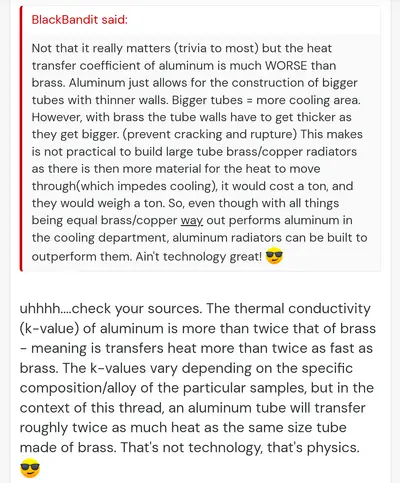At one point or another during your stewardship of an old vehicle you're likely to require a radiator replacement and boy, there are a LOT of options. So many, in fact, that's it's easy to get lost and order an ill-fitting piece or one of just plain low quality- especially if you're on a tight budget. I perused the offerings of Amazon, eBay, Rock Auto, Summit, etc. and although there are many similarities there are some stark differences as well as what I'm hoping are typos.
Say your OE copper/brass radiator is leaking and you can't find a competent specialist to repair it- you can try to solder/braze it yourself or even slather some goop on the leak but chances are that'll end with frustration, a mess, and a ruined radiator. So like many, you tuck the OE unit in the back of the garage never to be seen again... but at least you still have it. Now you need a replacement but don't know who to trust, what exactly you require, or even what's available... Hopefully this thread can alleviate some of those issues.
Cheap and directly to the point are so-called "Direct Fit" replacements with aluminum cores and plastic tanks. These are available from nearly every vendor you could imagine and though they vary in price and quality they're often so close that it's of no concern. You're looking for a "162" style, which is referencing the core used. This number applies to radiators with plastic OR aluminum tanks. They typically run around $100 and multiple people here have used them with moderate success. I'm using a Spectra radiator of that composition and it has served dutifully. I have no complaints concerning the fitment or quality but it sat full of coolant without being driven for a very long time and now that I'm using it, it leaks. I can't say if that's due to corrosion or electrolysis so let this be a reminder that aluminum corrodes over time and that you should always utilize a ground strap. Corrosion can be fought with sacrificial zinc anodes or liquid additives. Regardless of which type you choose remember this: the thermostat housing has an O.D. of 1 1/2", the water pump is 1 3/4", A Body radiators have 1 1/2" inlet/outlets, and "actual" G Bodies sport 1 1/4" inlets and 1 1/2" outlets. Most full aluminum radiators seem to call for 1 1/2" hoses so make sure your upper isn't 1 1/4"!
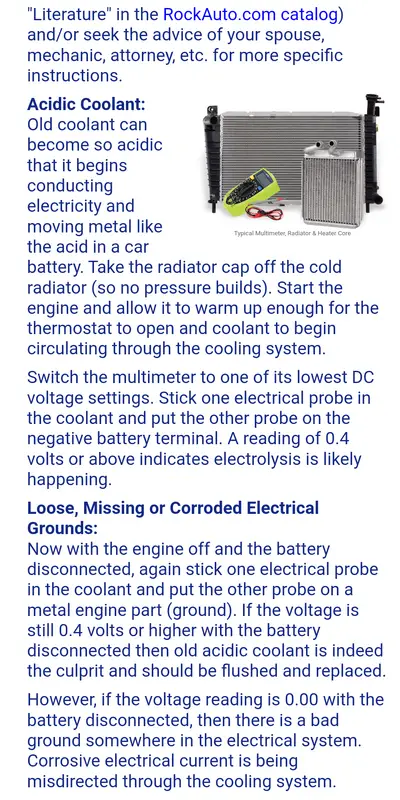
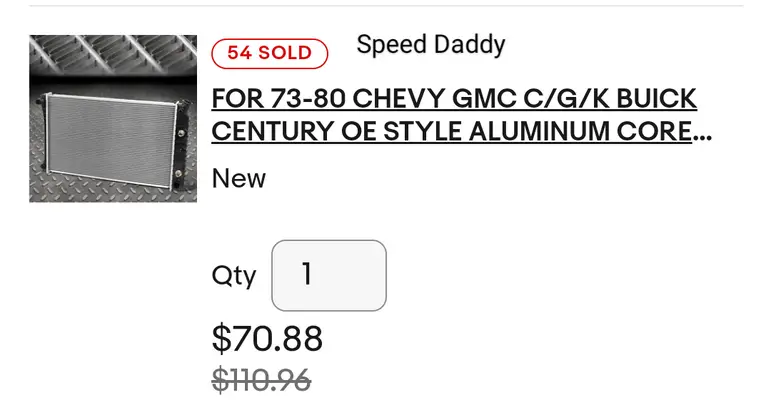
The next step up is an ALL aluminum radiator and this is where things get squirrelly. Originally, choices were limited so some opted for a radiator from a late '80s TPI Camaro or an LT1 version from the early '90s. A Modine "951" was a popular choice, but F Body units have smaller inlet/outlets and the inlet is higher, with the largest version being the "750". The transmission cooler lines are also different: the internal cooler is a couple of inches longer, placing the lower trans line beneath the lower radiator hose. You'll also need the F Body top plate or one from a Cutlass to hold things in place. The F Body plate may require drilling to fit. A '90s B Body such as a civilian model Caprice or Impala has a radiator with engine oil cooler lines (1157) but a core width of 30 1/2" so it requires cutting the core support to fit. Police models had external engine oil coolers, and you can use the stock B Body oil filter adapter or the ones from an '88-98 Z-71 4x4. You'll have a better chance at clearing headers if you use the adapter from a '94-'96 9C1 police cruiser, as they move the filter and lines closer to the oil pan and also use a smaller filter. But the days of a transplant radiator being necessary are over.
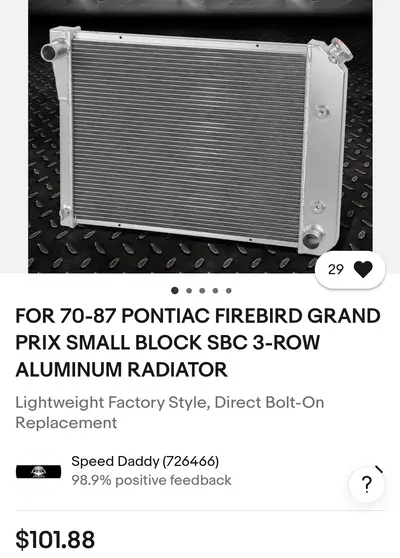
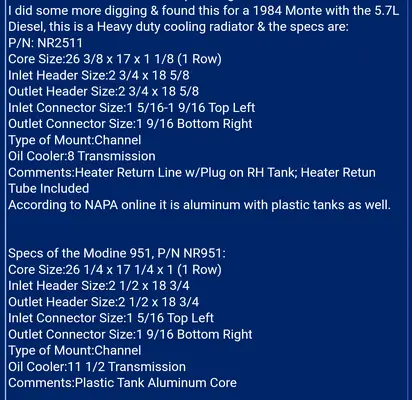
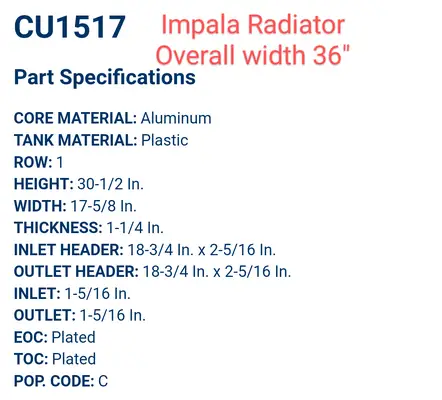
With manufacturers and vendors concerned only with profits they've created versions that fit multiple vehicles and you'll need to know some measurements to avoid ordering one that's too large. The core of the factory HD diesel radiator is 26 3/8" wide x 17" tall x 1 1/8" thick, which is thicker than the regular unit of only 1". The 1" cores are commonly listed with an "A" prefix or suffix. Remember these are core measurements, not overall size.
Armed with these measurements you'll find a myriad of units that say they'll fit, and they might, but what about quality? If we whittle down the list to include only vendors that we trust then things begin to clear up. Of course you can trust Griffin, Be Cool, Liland (Rock Auto), and the like but you'll pay at least $200 for one of those, and can go as high as $500. On the more budget friendly side of things there's Champion and others like them, and that's what this thread is about.
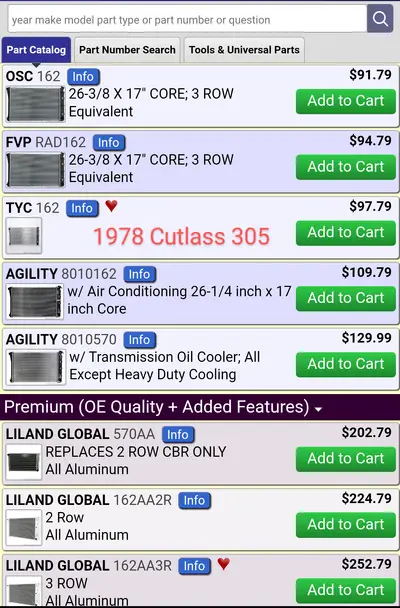
Personal experience, hearsay, and more research than I care to admit to has told me that many "off-brand" Amazon and eBay radiators are the same product in a different box, and I aimed to find the cheapest, best fitting radiator that met or exceeded what Champion offers. I know for a fact that Speed Daddy units are good quality and quite affordable, and that DNA Motoring and Superfast Racing are the exact same product. They just might be same as Champion but I'm not saying that. However, the other units are all identical down to the included plastic petcock and cheap Chinese cap.
I wanted to buy a Speed Daddy Nova/Camaro/Malibu unit for my Cutlass since it's bigger than the Grand Prix unit above but they only offer it with electric fans for $175. Not ready to make that change I scoped out the competition: Alloy Works and Radrepla offer the same multi-fit unit but it costs the same without fans, and Superfast Racing comes in around $110, no fans. Research indicates Blackhorse Racing is selling the same product for basically the same price. The Alloy Works and Radrepla units are slightly different, as their petcock is brass instead of plastic and the cap is a CNC machined 19 psi piece. They look to be of the same quality as the others but I can't say with 100% certainty, though the name Alloy Works has been tossed into the conversation on more than one occasion. All of these brands appear to utilize the same core and tanks, and boast the same fin count.
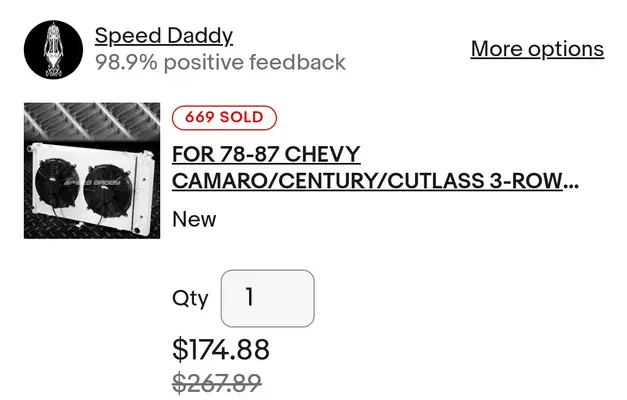
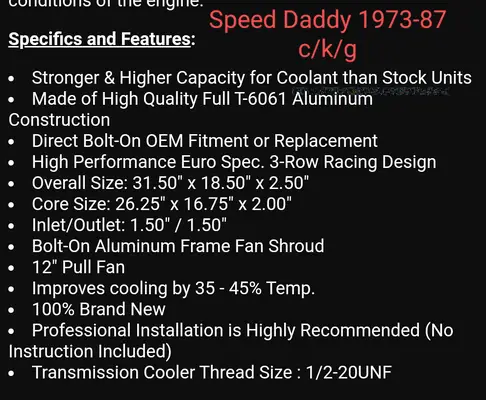
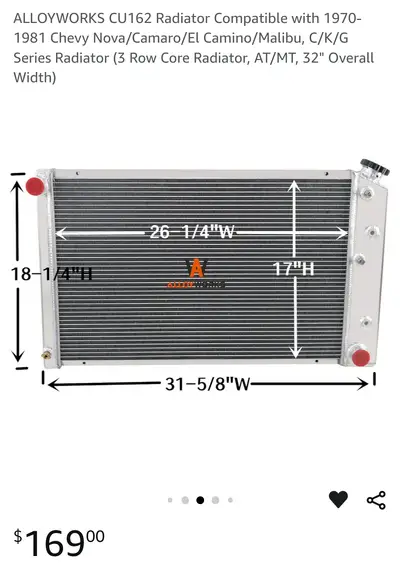

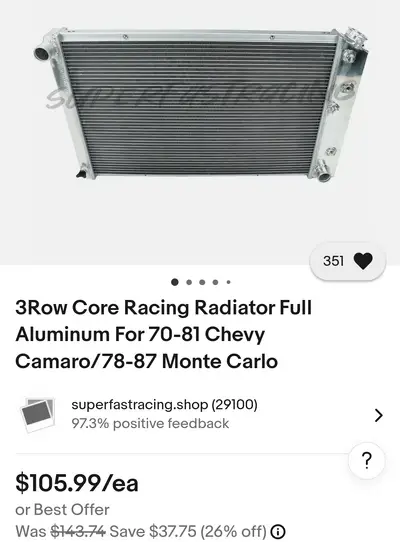
You have the choice of 2, 3, or even 4 rows to achieve optimum cooling but you're in for a surprise: you likely don't need 4 rows or even 3. The old copper/brass 4 row units are known to be the best factory choice for a big block or hot small block but aluminum can achieve the same thing in a smaller package. With copper, a larger tube diameter necessitates a thicker tube to avoid leaks- aluminum doesn't share that problem to the same degree so bigger tubes are easy for manufacturers to offer. Aluminum also touts a much better K value- in other words it transfers heat more than twice as fast as copper/brass. An aluminum tube will cool twice as quickly as a copper one of the same size. When you combine these two facts it adds up to this: an aftermarket 2 row aluminum radiator can out cool a 3 row copper/brass unit! Now, that's not only due to the K value and bigger tube size, it's due to the fact that with fewer tubes there's now more space between them, allowing more airflow. If a vendor offers 2 row and 3 row aluminum radiators with the same overall dimensions then the 2 row is actually a better unit if you're having heat issues. There's your surprise.
Now that you're looking for a G Body all aluminum radiator with 2 or 3 rows you'll find them listed as also fitting 1970s F Bodies, Bel Airs, Caprices, and even the venerable '73-'87 C/K Trucks! Be forewarned that the dual fitment listing does NOT mean that you can simply use a stock replacement "Direct Fit" unit for the other vehicle. Also, a radiator that fits a G Body and a Bel Air is different than one for a G Body and a truck, and both are different than the "Direct Fit" G Body replacement. So which is best? We may never know but differences include the width, height, thickness, and heater/trans line ports so choose carefully and mind the dimensions as well as the connections. I found discrepancies that I sure hope are typos but lacking trust led me to avoid any product that posted stats like the following. We want 1/2 - 20 UNF threads for the transmission cooler connection, not metric, not British.
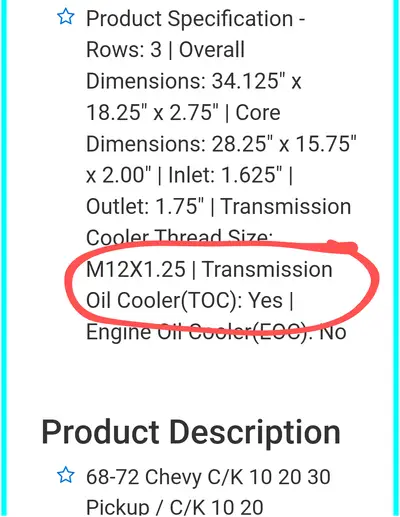
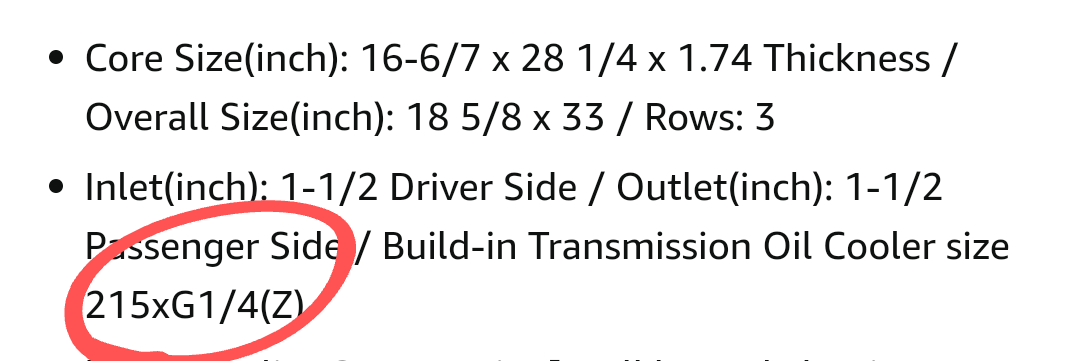
I decided to take a chance on the BlackHorse Racing unit, and for $115 it arrived on my doorstep in 4 days.
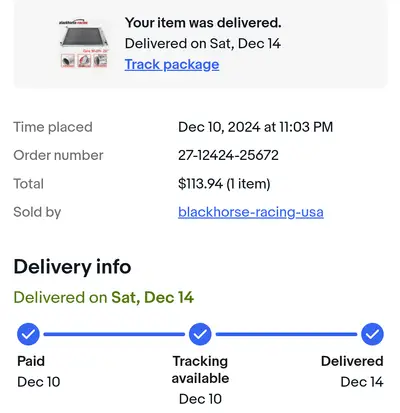
Everything looks to be in order and as of right now I'm pleased with my purchase. The fit and finish is just as good or better than every other radiator I've seen under $300:
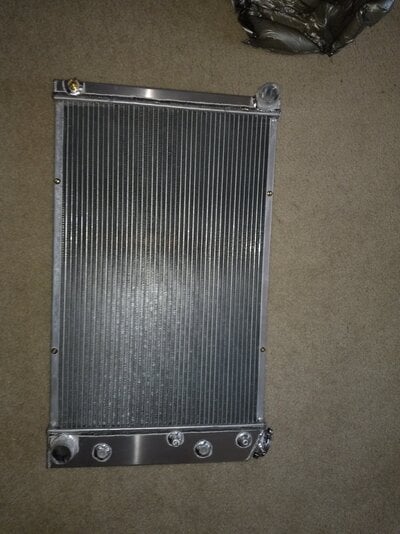
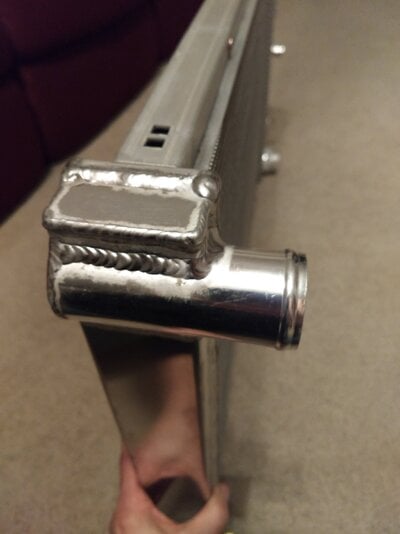
There are no dents, dings, scratches, or missing parts. The welds are all clean, the tubes and fins are straight, and the measurements are correct. It came with not only a brass drain petcock, but brass plugs in both coolant connectors on the tank, one of course being for a heater hose. Yup, the 3/4" hose nipple is internally threaded so you don't have to use an unsightly/ untrustworthy rubber cap. Interestingly, the two plugs have Teflon tape on them but the petcock does not.
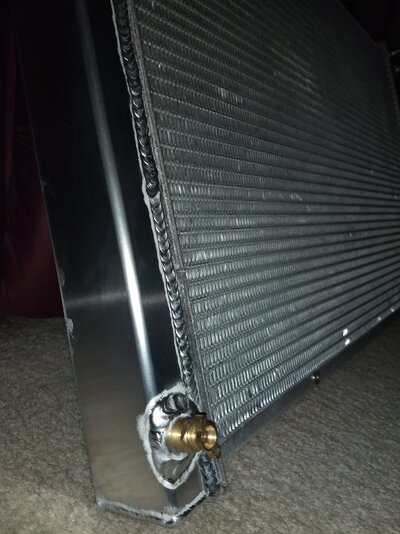
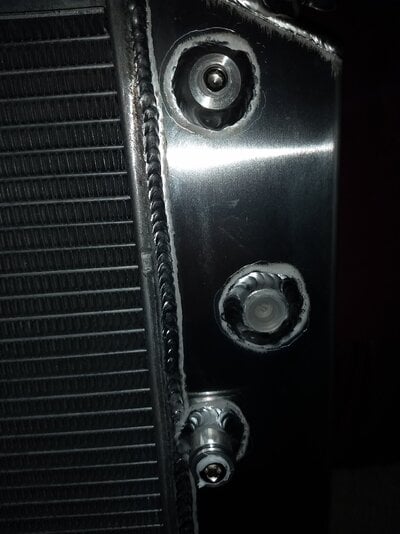
On the topic of caps, this radiator sports the same fill cap as the trusted (among the poor) Speed Daddy, DNA, and Superfast units. Additionally, it has Rivnuts high and low for mounting electric fans/ shrouds. I'm sure the others have the Rivnuts as well but I wasn't looking for nor did I see this feature listed in any of the descriptions while researching so it's a welcome surprise to me:
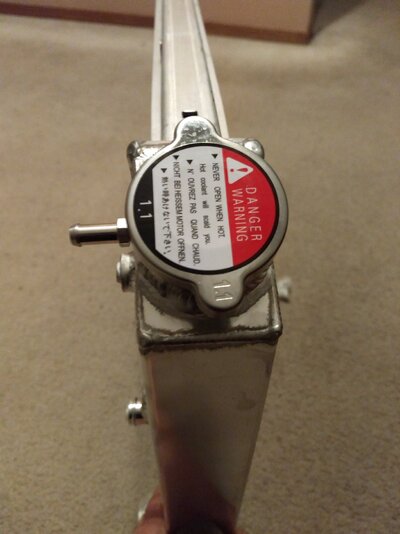
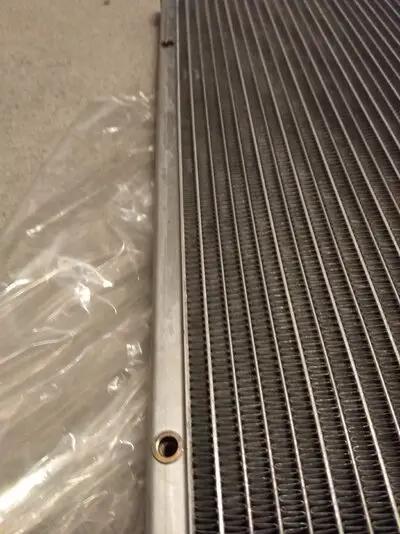
Since my Cutlass is bleeding green I aim to install this radiator ASAP and will note any problems if they occur. Following that it looks as though I'm the guinea pig for testing the durability of these budget friendly heat exchangers, and I welcome any and all questions.
Say your OE copper/brass radiator is leaking and you can't find a competent specialist to repair it- you can try to solder/braze it yourself or even slather some goop on the leak but chances are that'll end with frustration, a mess, and a ruined radiator. So like many, you tuck the OE unit in the back of the garage never to be seen again... but at least you still have it. Now you need a replacement but don't know who to trust, what exactly you require, or even what's available... Hopefully this thread can alleviate some of those issues.
Cheap and directly to the point are so-called "Direct Fit" replacements with aluminum cores and plastic tanks. These are available from nearly every vendor you could imagine and though they vary in price and quality they're often so close that it's of no concern. You're looking for a "162" style, which is referencing the core used. This number applies to radiators with plastic OR aluminum tanks. They typically run around $100 and multiple people here have used them with moderate success. I'm using a Spectra radiator of that composition and it has served dutifully. I have no complaints concerning the fitment or quality but it sat full of coolant without being driven for a very long time and now that I'm using it, it leaks. I can't say if that's due to corrosion or electrolysis so let this be a reminder that aluminum corrodes over time and that you should always utilize a ground strap. Corrosion can be fought with sacrificial zinc anodes or liquid additives. Regardless of which type you choose remember this: the thermostat housing has an O.D. of 1 1/2", the water pump is 1 3/4", A Body radiators have 1 1/2" inlet/outlets, and "actual" G Bodies sport 1 1/4" inlets and 1 1/2" outlets. Most full aluminum radiators seem to call for 1 1/2" hoses so make sure your upper isn't 1 1/4"!


The next step up is an ALL aluminum radiator and this is where things get squirrelly. Originally, choices were limited so some opted for a radiator from a late '80s TPI Camaro or an LT1 version from the early '90s. A Modine "951" was a popular choice, but F Body units have smaller inlet/outlets and the inlet is higher, with the largest version being the "750". The transmission cooler lines are also different: the internal cooler is a couple of inches longer, placing the lower trans line beneath the lower radiator hose. You'll also need the F Body top plate or one from a Cutlass to hold things in place. The F Body plate may require drilling to fit. A '90s B Body such as a civilian model Caprice or Impala has a radiator with engine oil cooler lines (1157) but a core width of 30 1/2" so it requires cutting the core support to fit. Police models had external engine oil coolers, and you can use the stock B Body oil filter adapter or the ones from an '88-98 Z-71 4x4. You'll have a better chance at clearing headers if you use the adapter from a '94-'96 9C1 police cruiser, as they move the filter and lines closer to the oil pan and also use a smaller filter. But the days of a transplant radiator being necessary are over.



With manufacturers and vendors concerned only with profits they've created versions that fit multiple vehicles and you'll need to know some measurements to avoid ordering one that's too large. The core of the factory HD diesel radiator is 26 3/8" wide x 17" tall x 1 1/8" thick, which is thicker than the regular unit of only 1". The 1" cores are commonly listed with an "A" prefix or suffix. Remember these are core measurements, not overall size.
Armed with these measurements you'll find a myriad of units that say they'll fit, and they might, but what about quality? If we whittle down the list to include only vendors that we trust then things begin to clear up. Of course you can trust Griffin, Be Cool, Liland (Rock Auto), and the like but you'll pay at least $200 for one of those, and can go as high as $500. On the more budget friendly side of things there's Champion and others like them, and that's what this thread is about.

Personal experience, hearsay, and more research than I care to admit to has told me that many "off-brand" Amazon and eBay radiators are the same product in a different box, and I aimed to find the cheapest, best fitting radiator that met or exceeded what Champion offers. I know for a fact that Speed Daddy units are good quality and quite affordable, and that DNA Motoring and Superfast Racing are the exact same product. They just might be same as Champion but I'm not saying that. However, the other units are all identical down to the included plastic petcock and cheap Chinese cap.
I wanted to buy a Speed Daddy Nova/Camaro/Malibu unit for my Cutlass since it's bigger than the Grand Prix unit above but they only offer it with electric fans for $175. Not ready to make that change I scoped out the competition: Alloy Works and Radrepla offer the same multi-fit unit but it costs the same without fans, and Superfast Racing comes in around $110, no fans. Research indicates Blackhorse Racing is selling the same product for basically the same price. The Alloy Works and Radrepla units are slightly different, as their petcock is brass instead of plastic and the cap is a CNC machined 19 psi piece. They look to be of the same quality as the others but I can't say with 100% certainty, though the name Alloy Works has been tossed into the conversation on more than one occasion. All of these brands appear to utilize the same core and tanks, and boast the same fin count.





You have the choice of 2, 3, or even 4 rows to achieve optimum cooling but you're in for a surprise: you likely don't need 4 rows or even 3. The old copper/brass 4 row units are known to be the best factory choice for a big block or hot small block but aluminum can achieve the same thing in a smaller package. With copper, a larger tube diameter necessitates a thicker tube to avoid leaks- aluminum doesn't share that problem to the same degree so bigger tubes are easy for manufacturers to offer. Aluminum also touts a much better K value- in other words it transfers heat more than twice as fast as copper/brass. An aluminum tube will cool twice as quickly as a copper one of the same size. When you combine these two facts it adds up to this: an aftermarket 2 row aluminum radiator can out cool a 3 row copper/brass unit! Now, that's not only due to the K value and bigger tube size, it's due to the fact that with fewer tubes there's now more space between them, allowing more airflow. If a vendor offers 2 row and 3 row aluminum radiators with the same overall dimensions then the 2 row is actually a better unit if you're having heat issues. There's your surprise.
Now that you're looking for a G Body all aluminum radiator with 2 or 3 rows you'll find them listed as also fitting 1970s F Bodies, Bel Airs, Caprices, and even the venerable '73-'87 C/K Trucks! Be forewarned that the dual fitment listing does NOT mean that you can simply use a stock replacement "Direct Fit" unit for the other vehicle. Also, a radiator that fits a G Body and a Bel Air is different than one for a G Body and a truck, and both are different than the "Direct Fit" G Body replacement. So which is best? We may never know but differences include the width, height, thickness, and heater/trans line ports so choose carefully and mind the dimensions as well as the connections. I found discrepancies that I sure hope are typos but lacking trust led me to avoid any product that posted stats like the following. We want 1/2 - 20 UNF threads for the transmission cooler connection, not metric, not British.


I decided to take a chance on the BlackHorse Racing unit, and for $115 it arrived on my doorstep in 4 days.

Everything looks to be in order and as of right now I'm pleased with my purchase. The fit and finish is just as good or better than every other radiator I've seen under $300:


There are no dents, dings, scratches, or missing parts. The welds are all clean, the tubes and fins are straight, and the measurements are correct. It came with not only a brass drain petcock, but brass plugs in both coolant connectors on the tank, one of course being for a heater hose. Yup, the 3/4" hose nipple is internally threaded so you don't have to use an unsightly/ untrustworthy rubber cap. Interestingly, the two plugs have Teflon tape on them but the petcock does not.


On the topic of caps, this radiator sports the same fill cap as the trusted (among the poor) Speed Daddy, DNA, and Superfast units. Additionally, it has Rivnuts high and low for mounting electric fans/ shrouds. I'm sure the others have the Rivnuts as well but I wasn't looking for nor did I see this feature listed in any of the descriptions while researching so it's a welcome surprise to me:


Since my Cutlass is bleeding green I aim to install this radiator ASAP and will note any problems if they occur. Following that it looks as though I'm the guinea pig for testing the durability of these budget friendly heat exchangers, and I welcome any and all questions.



